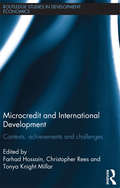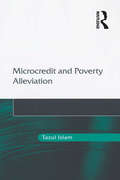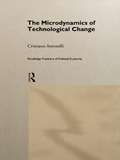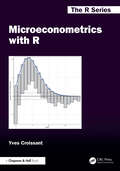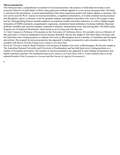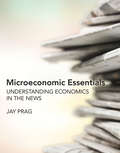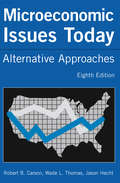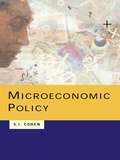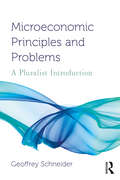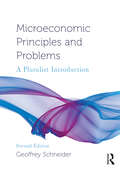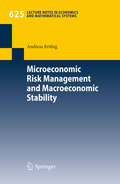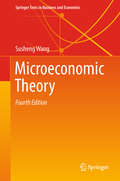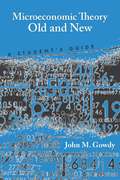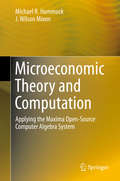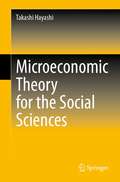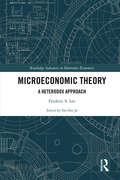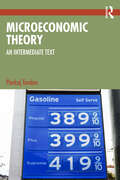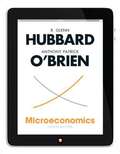- Table View
- List View
Microbrewery, Distillery, or Cidery
by The Staff of Entrepreneur MediaThe experts at Entrepreneur provide a two-part guide to success. First, craft enthusiasts and entrepreneurs looking to start their own brand of high-end beers and spirits will find the necessary tools and expert advice in this new addition to the popular Start Your Own series. Then, they'll master the fundamentals of business startup including defining their business structure, funding, staffing and more.This kit includes: Essential industry and business-specific startup steps with worksheets, calculators, checklists and more Entrepreneur Editors' Start Your Own Business, a guide to starting any business and surviving the first three years Interviews and advice from successful entrepreneurs in the industry Worksheets, brainstorming sections, and checklists Entrepreneur's Startup Resource Kit (downloadable)More about Entrepreneur's Startup Resource KitEvery small business is unique. Therefore, it's essential to have tools that are customizable depending on your business's needs. That's why with Entrepreneur is also offering you access to our Startup Resource Kit. Get instant access to thousands of business letters, sales letters, sample documents and more - all at your fingertips!You'll find the following:The Small Business Legal ToolkitWhen your business dreams go from idea to reality, you're suddenly faced with laws and regulations governing nearly every move you make. Learn how to stay in compliance and protect your business from legal action. In this essential toolkit, you'll get answers to the "how do I get started?" questions every business owner faces along with a thorough understanding of the legal and tax requirements of your business.Sample Business Letters1000+ customizable business letters covering each type of written business communication you're likelyto encounter as you communicate with customers, suppliers, employees, and others. Plus a complete guide to business communication that covers every question you may have about developing your own business communication style.Sample Sales LettersThe experts at Entrepreneur have compiled more than 1000 of the most effective sales letters covering introductions, prospecting, setting up appointments, cover letters, proposal letters, the all-important follow-up letter and letters covering all aspects of sales operations to help you make the sale, generate new customers and huge profits.
Microcredit Guarantee Funds In The Mediterranean
by Paola Leone Pasqualina PorrettaMicrofinance/microcredit today is facing two challenges. Firstly, it needs be more economically and financially sustainable. Secondly, it needs to increase its outreach in order to have a more significant impact on poorer areas of the world. Access to credit for the poorest people is a trade-off between economic and financial sustainability and the spread of activity. Greater innovation in processes and products is required in order to reduce transactional costs and informational asymmetries, extend the term structure of contracts and provide suitable assessment and risk management in the microfinance sector. This book offers a comprehensive comparative analysis of the most significant models of microcredit guarantee funds adopted in three South European countries (Italy, France, Spain) and in three North African countries (Morocco, Tunisia, Egypt). It provides a clear picture of microcredit guarantee funds in each country, focusing on three keys areas: analysis of the regulatory framework, mapping of microcredit institutions and analysis of the main features of guarantee funds. The authors highlight the strengths and weaknesses of the microcredit guarantee system and provide regulatory or operative solutions which may improve the economic sustainability of microcredit institutions and, ultimately, contribute to facilitating access to credit for microenterprises and the microborrower. The book will be a valuable resource for supervisors, microcredit institutions, guarantee intermediaries and financial intermediaries.
Microcredit and International Development: Contexts, Achievements and Challenges (Routledge Studies In Development Economics Ser. #92)
by Farhad Hossain Christopher Rees Tonya Knight MillarThis book draws together a set of topical writings on the subject of microcredit that will be of relevance to the work of both researchers and practitioners in the field. In drawing on the experiences of authors from countries and regions throughout the globe, including Cambodia, Barbados and the Caribbean, Mexico, Pakistan, India and Africa, the book examines the subject of microcredit from various perspectives. The book explores the contribution of microcredit to various sectors within the developed and developing worlds and seeks to analyze critically the contributory success and failure factors of microcredit in varying international contexts. By means of evaluating the opportunities and challenges of microcredit, the book provides key lessons about microcredit for international development purposes. More specifically, the authors of the chapters offer a series of insights into microcredit activities as they relate to the real world. For example, in his chapter, David Hulme traces the developing nature of the activities of the highly influential Grameen Bank, that is, from activities focused on subsidised microcredit to more market-based microfinance activities. In their chapter, Johanna Hietalahti and Anja Nygren examine microcredit as a socio-political institution in South Africa and, in doing so, unearth the complex interactions between of rules, logic and power-relations which are relevant to microcredit activities. In another chapter, Asad Ghalib uses the context of Rural Punjab in Pakistan in order to assess the extent to which microcredit-related activities actually reach the poor. Taken together, the chapters in the book provide readers with an opportunity to consider a host of factors connected to microcredit from a genuinely international perspective.
Microcredit and Poverty Alleviation
by Tazul IslamThe attempt of the Grameen Bank to alleviate poverty and enhance the skills and productivity of its rural women clients provides the fascinating backdrop to this important study of micro-credit institutions. Tazul Islam examines the real extent to which the Grameen Bank's credit-alone policy has been successful in securing the Bank's financial sustainability; its practical role in alleviating poverty and its actual impact on the productivity of its clients. This book concludes by considering alternative policy options that hold out the possibility of increased poverty alleviation.
Microdynamics of Technological Change (Routledge Frontiers of Political Economy)
by Cristiano AntonelliThis volume presents a comprehensive assessment of the economic effects of the emerging information and communication technologies associated with a knowledge-based economy, and looks at how knowledge is increasingly treated as a product in its own right. An original framework is developed to comprehend these fundamental shifts, based on three bodies of knowledge: * the economics of path dependence and of historical time as they are elaborated in the economics of new technologies * economic topology based on the methodology of network analysis * the new economics of knowledge and the concept of localized technological change This book provides a unified analytical framework for the study of the transition of advanced economic systems towards a knowledge-based economy.
Microeconometrics
by A. Colin Cameron Pravin K. TrivediAn outstanding introduction to microeconometrics and how to do microeconometric research using Stata, this book covers topics often left out of microeconometrics textbooks and omitted from basic introductions to Stata. Cameron and Trivedi provide the most complete and up-to-date survey of microeconometric methods available in Stata. They begin by introducing simulation methods and then use them to illustrate features of the estimators and tests described in the rest of the book. They address each topic with an in-depth Stata example and demonstrate how to use Stata's programming features to implement methods for which Stata does not have a specific command. Multi/Card Deck Copy
Microeconometrics with R (Chapman & Hall/CRC The R Series)
by Yves CroissantThis book is about doing microeconometrics, defined by Cameron and Trivedi as "the analysis of individual-level data on the economic behavior of individuals or firms using regression methods applied to cross-section and panel data" with R. Microeconometrics became increasingly popular in the last decades, thanks to the availability of many individual data sets and to the development of computer performance.R appeared in the late nineties as a clone of S. It became increasingly popular among statisticians, especially in fields where S was widely used. Twenty years ago, using R for doing econometrics analysis required a lot of programming because a lot of core methods of econometrics were not available in R. Nowadays, most of the basic methods described in the book are available in contributed packages. Moreover, the set of packages called the tidyverse developed by RStudio (now Posit) for all the basic tasks of an applied statistician (importing, tidying, transforming and visualizing data sets) makes the use of R faster and easier. The book uses extensively specialized econometrics packages and the tidyverse, and it seeks to demonstrate that the adoption of R as the primary software for an econometrician is a relevant choice.The first part of the book is devoted to the ordinary least squares estimator. Matrix algebra is progressively introduced in this part, and special attention is paid to the interpretation of the estimated coefficients. The second part goes beyond the basic OLS estimator by testing the hypothesis on which this estimator is based and providing more complex estimators relevant when some of these hypotheses are violated. Finally, the third part of the book presents specific estimators devoted to "special" responses, e.g., count, binomial or duration data.Key Features: Many applications using data sets of recent academic works are developed Testing and estimation procedures using the programming framework of R and specialized packages are presented Two companion packages (micsr and micsr.data), containing respectively functions implementing some estimation and testing procedures not available in other contributed packages and data sets used in the book, are provided
Microeconometrics: Methods and Applications
by A. Colin Cameron Pravin K. TrivediThis book provides the most comprehensive treatment to date of microeconometrics, the analysis of individual-level data on the economic behavior of individuals or firms using regression methods for cross section and panel data. The book is oriented to the practitioner. A basic understanding of the linear regression model with matrix algebra is assumed. The text can be used for a microeconometrics course, typically a second-year economics PhD course; for data-oriented applied microeconometrics field courses; and as a reference work for graduate students and applied researchers who wish to fill in gaps in their toolkit. <p><p>Distinguishing features of the book include emphasis on nonlinear models and robust inference, simulation-based estimation, and problems of complex survey data. The book makes frequent use of numerical examples based on generated data to illustrate the key models and methods. More substantially, it systematically integrates into the text empirical illustrations based on seven large and exceptionally rich data sets.
Microeconomic Analysis (Routledge Revivals): Essays in Microeconomics and Economic Development
by David Currie, David Peel and Will PetersFirst published in 1981, this book brings together a collection of essays on microeconomics and development presented at the conference of the Association of University Teachers of Economics. Topics covered include the intergenerational transfer of economic inequality, a review of the recent development in the theory of equity in the economy’s distribution and production process, labour and unemployment, market structure and international trade, taxation and the public sector, Third World industrialisation and Indian agriculture. This book will be of interest to students of Economics and Development Studies.
Microeconomic Essentials: Understanding Economics in the News
by Jay PragA concise and nontechnical introduction to microeconomics, emphasizing concepts over mathematics, with real-world examples and applications.This concise and nontechnical introduction to microeconomics emphasizes concepts over mathematics. Keeping in mind that sometimes the most accurate model is not very useful in the real world, Microeconomic Essentials balances economics as mathematics with economics as a social process. Microeconomics is part of daily life; gas prices, wage increases, the rising cost of health care, international trade: all are microeconomic topics. Therefore, like its predecessor, Macroeconomic Essentials, this textbook accompanies its explanations with examples and real-world applications.
Microeconomic Foundations I: Choice and Competitive Markets
by David M. KrepsA guide to mastering microeconomic theoryMicroeconomic Foundations I develops the choice, price, and general equilibrium theory topics typically found in first-year theory sequences, but in deeper and more complete mathematical form than most standard texts provide. The objective is to take the reader from acquaintance with these foundational topics to something closer to mastery of the models and results connected to them.Provides a rigorous treatment of some of the basic tools of economic modeling and reasoning, along with an assessment of the strengths and weaknesses of these toolsComplements standard textsCovers choice, preference, and utility; structural properties of preferences and utility functions; basics of consumer demand; revealed preference and Afriat's Theorem; choice under uncertainty; dynamic choice; social choice and efficiency; competitive and profit-maximizing firms; expenditure minimization; demand theory (duality methods); producer and consumer surplus; aggregation; general equilibrium; efficiency and the core; GET, time, and uncertainty; and other topicsFeatures a free web-based student's guide, which gives solutions to approximately half the problems, and a limited-access instructor's manual, which provides solutions to the rest of the problemsContains appendixes that review most of the specific mathematics employed in the book, including a from-first-principles treatment of dynamic programming
Microeconomic Issues Today: Alternative Approaches
by Robert B. CarsonNow revised and updated to reflect critical changes in economic policy since the last edition, Microeconomic Issues Today, Eighth Edition, provides Conservative, Liberal, and Radical interpretations and solutions for seven current microeconomic issues. An instructor's manual with a test bank and discussion questions is available to professors who adopt the text, and PowerPoint downloads are available as teaching aids.
Microeconomic Policy
by Solomon CohenThis textbook provides an important and fresh approach to the understanding of microeconomic policy. Microeconomic Policy links principles to settings and shows how theory compliments policy and vice-versa. By linking theory to policies and application, this text will enable students to acquire proficiency and recognise balance in policy analysis and preparation. It contains comprehensive coverage of a broad range of policy areas including:* competition and technology policy* information and governance policy* industrial and environmental policy* social and income policy* public sector failure and reform.
Microeconomic Principles and Problems: A Pluralist Introduction (Routledge Pluralist Introductions to Economics)
by Geoffrey SchneiderMicroeconomic Principles and Problems offers a comprehensive introduction to all major perspectives in modern economics, including mainstream and heterodox approaches. Through providing multiple views of markets and how they work, it will leave readers better able to understand and analyse the complex behaviours of consumers, firms, and government officials, as well as the likely impact of a variety of economic events and policies. Most principles of microeconomics textbooks cover only mainstream economics, ignoring rich heterodox ideas. They also lack material on the great economists, including the important ideas of Adam Smith, Karl Marx, Thorstein Veblen, John Maynard Keynes and Friedrich Hayek. Mainstream books neglect the kind of historical analysis that is crucial to understanding trends that help us predict the future. Moreover, they focus on abstract models more than existing economic realities. This engaging book addresses these inadequacies. Including explicit coverage of the major heterodox schools of thought, it allows the reader to choose which ideas they find most compelling in explaining modern economic realities. Written in an engaging style focused on real world examples, this ground-breaking book brings economics to life. It offers the most contemporary and complete package for any pluralistic microeconomics class.
Microeconomic Principles and Problems: A Pluralist Introduction (Routledge Pluralist Introductions to Economics)
by Geoffrey SchneiderMicroeconomic Principles and Problems offers a comprehensive introduction to all major perspectives in modern microeconomics, including mainstream and heterodox approaches. By providing multiple views of markets and how they work, readers will be better able to understand and analyze the complex behaviors of consumers, firms, and government officials, as well as the likely impact of a variety of economic events and policies. Most principles textbooks cover only mainstream economics and neglect the rich contextual analysis of heterodox economists. Heterodox material is presented as complementary to mainstream economics: understanding both approaches yields the deepest level of understanding. The book covers standard models, and includes substantial coverage of existing economic realities, featuring case studies and descriptive data. The book includes some coverage of all major heterodox schools of thought. This second edition incorporates new and expanded material on international trade (including disintegration and Brexit), climate issues and perspectives including degrowth, inter-temporal exchanges and games, non-market exchanges, trends in job opportunities, the rising cost of education, the gig economy, social media as an industry, and updated examples and cases. The book’s suite of digital resources has also been revised to ensure examples and activities are relevant to each part of the book. Written in an engaging style focused on real-world examples, this groundbreaking book brings economics to life. It offers the most contemporary and complete package for any pluralist microeconomics class.
Microeconomic Risk Management and Macroeconomic Stability
by Andreas RöthigWhile the determinants of firms' optimal hedging strategies on the micro level are well understood, there is rarely any literature dealing with macroeconomic consequences of microeconomic risk management. This book is concerned with the impact of diverse hedging policies on macroeconomic stability. It addresses this issue by employing theoretical as well as empirical methods.
Microeconomic Theory (Springer Texts in Business and Economics)
by Susheng WangThis book covers microeconomic theory at the Master’s and Ph.D levels for students in business schools and economics departments. It concisely covers major mainstream microeconomic theories today, including neoclassical microeconomics, game theory, information economics, and contract theory. The revamped, 3rd edition of "Microeconomic Theory" offers faculty, graduate and upper undergraduate students with a comprehensive curriculum solution.
Microeconomic Theory Old and New
by John M. GowdyThis volume begins by explaining the basics of Walrasian general equilibrium theory, a model the author says that all contemporary economists must understand, even if they end up disagreeing with it. And Gowdy (economics, Rensselaer Polytechnic Institute) does disagree with aspects of it, as becomes apparent with even a casual reading. In the first part of the book he does a thorough, mostly objective job in explaining the underlying theories of modern economics, but does add regular comments about the assumptions and simplifications that were made in its formulation. In the second part one senses that he comes into his own, exploring theoretical and behavioral critiques of Walrasian theory and suggesting new approaches such as behavioral economics and evolutionary game theory and the necessity of incorporating the natural resource base into equations. Annotation ©2010 Book News, Inc. , Portland, OR (booknews. com)
Microeconomic Theory and Computation
by J. Wilson Mixon Michael R. HammockEconomists can use computer algebra systems to manipulate symbolic models, derive numerical computations, and analyze empirical relationships among variables. Maxima is an open-source multi-platform computer algebra system that rivals proprietary software. Maxima's symbolic and computational capabilities enable economists and financial analysts to develop a deeper understanding of models by allowing them to explore the implications of differences in parameter values, providing numerical solutions to problems that would be otherwise intractable, and by providing graphical representations that can guide analysis. This book provides a step-by-step tutorial for using this program to examine the economic relationships that form the core of microeconomics in a way that complements traditional modeling techniques. Readers learn how to phrase the relevant analysis and how symbolic expressions, numerical computations, and graphical representations can be used to learn from microeconomic models. In particular, comparative statics analysis is facilitated. Little has been published on Maxima and its applications in economics and finance, and this volume will appeal to advanced undergraduates, graduate-level students studying microeconomics, academic researchers in economics and finance, economists, and financial analysts.
Microeconomic Theory for the Social Sciences
by Takashi HayashiThis textbook covers microeconomic theory at the level of intermediate and advanced undergraduates. It is also intended as an introduction for those with other intellectual and academic backgrounds who may not necessarily agree with “mainstream” economists but at least are interested knowing how they think and see things.The book provides thorough explanations of definitions and assumptions that the theory is based upon. It provides comprehensive accounts of motivations and reservations behind the theory. As well, it precisely presents the logical process of how the assumptions lead to the conclusion, conveying the intuition and the key of the arguments. An abundance of topics is included here: individual choice, general equilibrium, partial equilibrium, game theory, imperfect competition, transaction under incomplete information, market failures, welfare economics, social choice and mechanism design. The book is a valuable resource for any reader studying or simply interested in microeconomic theory.
Microeconomic Theory second edition: Concepts and Connections
by Michael E. WetzsteinThis book introduces the main concepts of microeconomics to upper division undergraduate students or first year graduate students who have undergone at least one elementary calculus course. The book fully integrates graphical and mathematical concepts and offers over 150 analytical examples demonstrating numerical solutions. The book has a strong theoretical basis but shows how microeconomics can be brought to bear on the real world. New Features for this edition include: an incorporation of the theory of stock externalities associated with greenhouse gases development of the section on insurance with particular reference to the new US healthcare program greater integration of game theoretic concepts throughout the book. The book’s style is accessible, but also rigorous. Mathematical examples are provided throughout the book, in particular for key concepts and the result is a balanced approach in terms of prose, graphics, and mathematics.
Microeconomic Theory: A Heterodox Approach (Routledge Advances in Heterodox Economics)
by Frederic S. LeeMicroeconomic Theory: A Heterodox Approach develops a heterodox economic theory that explains the economy as the social provisioning process at the micro level. Heterodox microeconomics explores the economy with a focus on its constituent parts and their reproduction and recurrence, their integration qua interdependency by non-market and market arrangements and institutions, and how the system works as a whole. This book deals with three theoretical concerns. Due to the significance of the price mechanism to mainstream economics, a theoretical concern of the book is the business enterprise, markets, demand, and pricing. Also, since heterodox economists see private investment, consumption and government expenditures as the principal directors and drivers of economic activity, a second theoretical concern is business decision-making processes regarding investment and production, government expenditure decisions, the financing of investment, the profit mark-up and the wage rate, and taxes. Finally, the third theoretical concern of the book is the delineation of a non-equilibrium disaggregated price-output model of the social provisioning process. This book explores the integration of these various theories with a theoretical model of the economy and how this forms a theory that can be identified as heterodox microeconomics. It will be of interest to both postgraduates and researchers.
Microeconomic Theory: An Intermediate Text
by Pankaj TandonThis book provides a comprehensive analysis of the theoretical tools, real-world applications, policy implications and corner solutions of microeconomics.It offers a discussion of all significant topics including applications and extension of consumer theory, theory of the firm, production, cost and supply, partial and general equilibrium, welfare economics, uncertainty and information, and market imperfections as well as a detailed overview of the theory of games. Apart from all the topics receiving both the algebraic and geometric treatment, the other distinguishing features of the book are an emphasis on policy implications and a full treatment of corner solutions. This latter feature has arisen out of the realization that students easily master interior solutions by memorizing the standard first-order conditions but do not necessarily understand the underlying concepts. Complete with several original algebraic derivations and graphical expositions, this book will serve as an indispensable textbook for students of microeconomics.The book will be useful to students, researchers, and teachers of economics, international economics, industrial economics, managerial economics, and agricultural economics. It will also be a useful reference for those studying public policy and law.
Microeconomics
by Anthony P. O'Brien Glenn P. HubbardLearn economics through real business examples. Hubbard/O'Brien explains the basics of economics by demonstrating how real businesses use economics to make real decisions everyday. This is something all readers can connect to, as they encounter businesses in their daily lives. And regardless of future career path--opening an art studio, doing social work, trading on Wall Street, working for the government, or bartending at the local pub--readers will benefit from understanding the economic forces behind their work.
Microeconomics
by Chad Syverson Austan Goolsbee Steven LevittLike no other text for the intermediate microeconomics course, Goolsbee, Levitt, and Syverson's Microeconomics bridges the gap between today's theory and practice, with a strong empirical dimension that lets students tests theory and successfully apply it. With carefully crafted features and vivid examples, Goolsbee, Levitt, and Syverson's text helps answer two critical questions students ask, "Do people and firms really act as theory suggests?" and "How can someone use microeconomics in a practical way?" The authors teach in economics departments and business schools and are active empirical microeconomics researchers. Their grounding in different areas of empirical research allows them to present the evidence developed in the last 20 years that has tested and refined fundamental theories. Their teaching and professional experiences are reflected in an outstanding presentation of theories and applications.


